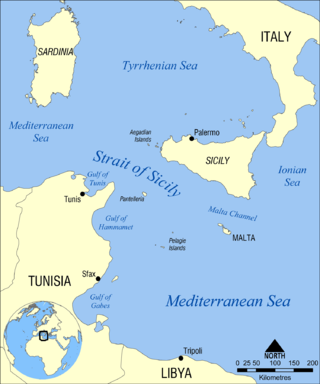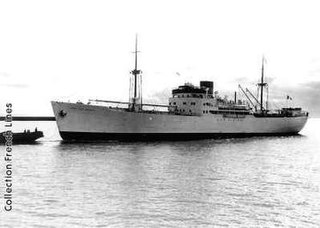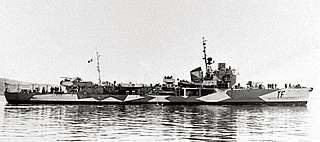
HMS Jaguar was a J-class destroyer of the Royal Navy. Commissioned in September 1939, she was present at the Dunkirk evacuation the following year, during which Jaguar was damaged by dive bombers. She later served in the Mediterranean and was involved in several actions there. She was torpedoed off the coast of Egypt on 26 March 1942 and sunk.

HMS Havock was an H-class destroyer built for the British Royal Navy in the mid-1930s. During the Spanish Civil War of 1936–1939, the ship enforced the arms blockade imposed by Britain and France on both sides as part of the Mediterranean Fleet. During the first few months of the Second World War, Havock searched for German commerce raiders in the Atlantic Ocean and participated in the First Battle of Narvik during the Norwegian Campaign of April–June 1940 before she was transferred back to the Mediterranean Fleet in May where she escorted a number of convoys to Malta. The ship took part in the Battle of Cape Spada in July 1940, the Battle of Cape Matapan in March 1941 and the evacuation of Greece in April 1941. She was damaged during the Battle of Crete the following month, but participated in the Syria–Lebanon Campaign in June.

The Battle of the Mediterranean was the name given to the naval campaign fought in the Mediterranean Sea during World War II, from 10 June 1940 to 2 May 1945.

The naval Battle of Cape Bon took place on 13 December 1941 during the Second World War, between two Italian light cruisers and an Allied destroyer flotilla, off Cape Bon in Tunisia.

The First Battle of Sirte was fought between forces of the British Mediterranean Fleet and the Regia Marina during the Battle of the Mediterranean in the Second World War. The engagement took place on 17 December 1941, south-east of Malta, in the Gulf of Sirte. The engagement was inconclusive as both forces were protecting convoys and wished to avoid battle.

Operation Stonewall was an Allied naval and air operation in the Second World War from 26 to 27 December 1943, to intercept blockade-runners sailing to German-occupied France through the Bay of Biscay. Operations Barrier and Freecar, by the Allied navies and the Brazilian Air Force, had taken place in the south- and mid-Atlantic. The ships were tracked by OP-20-G and British code-breakers, which decrypted Japanese machine cyphers and German Enigma machine transmissions to U-boats and blockade-runners.

Operation Retribution was the Second World War air and naval blockade designed to prevent the seaborne evacuation of Axis forces from Tunisia to Sicily. Axis forces were isolated in northern Tunisia and faced Operation Vulcan, the final Allied assault. The equivalent blockade of air evacuation was Operation Flax.

The Battle of the Tarigo Convoy was a naval battle of the Second World War, part of the Battle of the Mediterranean. It was fought on 16 April 1941, between four Royal Navy destroyers and three Italian destroyers of the Regia Marina which were escorting a convoy near the Kerkennah Islands off Sfax, on the Tunisian coast.

The Battle of the Duisburg Convoy was fought on the night of 8/9 November 1941 between an Italian convoy, its escorts and four British ships. The convoy was named BETA by the Italian naval authorities and carried supplies for the Italian Army civilian colonists and the Afrika Korps in Italian Libya.

HMS Paladin was a P-class destroyer of the Royal Navy that served in the Second World War. She was built by John Brown and Co. Ltd., Clydebank. She saw action in the Mediterranean and Far East. After the war she was converted into a type 16 frigate and was eventually scrapped in 1962.

The Battle of Skerki Bank was an engagement during the Second World War which took place near Skerki Bank in the Mediterranean Sea in the early hours of 2 December 1942. Force Q, a flotilla of Royal Navy cruisers and destroyers, attacked Convoy H, an Italian convoy and its Regia Marina escort of destroyers and torpedo boats.

The Battle of the Cigno Convoy was a naval engagement between two British destroyers of the Royal Navy and two torpedo boats of the Regia Marina south-east of Marettimo island to the west of Sicily, in the early hours of 16 April 1943. The Italian ships were escorting the transport ship Belluno to Tunisia; the torpedo boat Tifone, carried aviation fuel. The British force was fought off by the Italian ships for the loss of a torpedo boat. A British destroyer, disabled by Italian gunfire, had to be scuttled after the action when it was clear that it could not make port before dawn.
HMS Marigold was a Flower-class corvette of the Royal Navy. She was launched on 4 September 1940 and was sunk by an Italian air-dropped torpedo on 9 December 1942.

HMS Westcott (D47) was a Royal Navy Admiralty W-class destroyer that served in the Second World War. In the Second World War Westcott served in an anti-submarine role and escorted numerous Atlantic and Malta convoys.

Arctic naval operations of World War II were the World War II naval operations that took place in the Arctic Ocean, and can be considered part of the Battle of the Atlantic and/or of the European Theatre of World War II.

The Battle off Zuwarah was a naval night encounter during the Second World War. The battle took place in Libyan waters between the Royal Navy and the Regia Marina. An Italian flotilla of small minesweepers and auxiliary vessels evacuating Tripoli was destroyed by two British destroyers.

Saverio Marotta was an Italian naval officer during World War II known for his actions in command of the torpedo boat Perseo. Previously, he had been stationed on several cruisers during the Spanish Civil War and early World War II starting as an ensign and working his way up to his final rank of lieutenant commander. After being put in command of the Perseo in August 1942 he took part in at least two actions of note against a numerically superior foe, the defence of the D'Annunzio, and the steamer Campobasso. He was wounded in action in the defence of the Campobasso, later drowning attempting to reboard his sinking vessel, he was awarded the Gold Medal of Military Valor for his efforts in defending the Campobasso.

Tifone was a Ciclone-class torpedo boat that served with the Italian Navy during the Second World War. The vessel entered service on 11 July 1942 and was scuttled on 7 May 1943 at Korbous, Tunisia. She escorted the last Axis convoy to reach Africa in World War II.
The German torpedo boat TA37 was an Ariete-class torpedo boat operated by the German Kriegsmarine during the Second World War. The ship was built for the Italian Navy by the shipbuilder CRDA at their Trieste shipyard with the name Gladio in 1943, but was incomplete when Italy surrendered to the Allies in September 1943, and was seized by Nazi Germany. The ship entered service as TA37 in 1944, serving in the Adriatic and Aegean seas and was sunk by British destroyers on 7 October 1944.
The German torpedo boat TA24 was an Ariete-class torpedo boat operated by the German Kriegsmarine during the Second World War. The ship was built for the Italian Navy by the shipbuilder Ansaldo at their Genoa shipyard with the name Arturo in 1943, but was incomplete when Italy surrendered to the Allies in September 1943, and was seized by Nazi Germany. The ship entered service as TA24 in October 1943, serving in the Tyrrhenian Sea and was sunk by British destroyers on 18 March 1945.



















